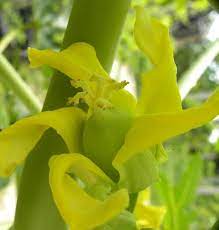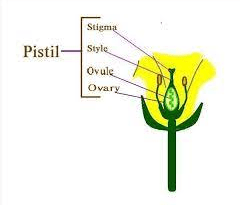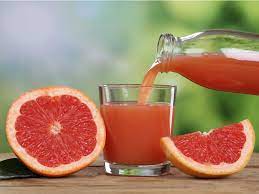PawPaw/Papaya Sepals: Economic Importance, Uses, and by-Products
PawPaw/Papaya Sepals are an important part of the flower structure. Sepals are typically green, leaf-like structures that enclose and protect the developing flower bud before it blooms. They are part of the outermost whorl of floral parts, known as the calyx, and are usually found just beneath the petals.
In the case of papaya (Carica papaya), the sepals are typically green, and they enclose the petals and other reproductive structures of the flower. The sepals provide protection to the inner floral parts as the flower develops and can also play a role in attracting pollinators. Sepals may vary in shape and size depending on the species and variety of the plant.
In the case of the pawpaw (Asimina triloba), which is a different fruit tree, the sepals serve a similar function. They are green and enclose the flower bud, protecting it until it’s ready to open and be pollinated. Once the flower blooms, the sepals may remain attached, but they are usually less prominent than the colorful petals and may eventually wither and fall away as the fruit begins to develop.
Sepals are present in both papaya and pawpaw flowers, and they serve to protect and enclose the developing flower buds before they open and become receptive to pollination.
The Economic Importance and Uses of PawPaw/Papaya Sepals

Papaya, also known as pawpaw in some regions, is a tropical fruit that is well-known for its delicious flesh and a wide range of health benefits. While the flesh of the fruit is the most commonly consumed part, other parts of the papaya plant, including the sepals, can also have various uses and importance.
Here are some of the importance and uses of papaya sepals:
1. Flavoring: Papaya sepals have a mildly sweet and slightly peppery taste. They can be used as a flavoring agent in various dishes, especially in salads and salsas, to add a unique taste.
2. Digestive Aid: Papaya sepals are known for their digestive properties. They contain enzymes like papain, which can aid in digestion and help prevent constipation. They are sometimes used in traditional medicine as a natural remedy for digestive issues.
3. Anti-Inflammatory: The enzymes in papaya sepals, including papain, have anti-inflammatory properties. They can be applied topically or consumed to reduce inflammation and promote wound healing.
4. Natural Diuretic: Papaya sepals are diuretic in nature, which means they can promote urine production and help the body eliminate excess salt and water. This property can be beneficial for individuals with conditions like edema or high blood pressure.
5. Menstrual Aid: In some traditional herbal practices, papaya sepals are used to regulate menstrual cycles and alleviate menstrual pain.
6. Natural Pest Control: Papaya sepals are believed to have insect-repellent properties. In some cultures, they are placed in food storage areas or used as a natural pesticide to keep insects away from crops.
7. Skin Care: Papaya sepals can be used in homemade face masks and skincare treatments due to their enzyme content. They are believed to have exfoliating and rejuvenating properties that can help improve the texture and tone of the skin.
Read Also: PawPaw/Papaya Stamen: Economic Importance, Uses and By-Products
8. Folk Medicine: In traditional medicine in various regions, papaya sepals have been used to treat a range of ailments, from digestive issues to skin conditions and even as an anthelmintic to expel intestinal parasites.
The Products and By-products That Can Be Derived From PawPaw/Papaya Sepals
Papaya (or pawpaw) sepals are typically not considered a primary source for products or by-products in the same way that the fruit itself, leaves, or seeds are. However, some uses for papaya sepals and by-products could include:
1. Natural Dye: The sepals of papaya, especially when dried, can be used as a natural dye. They may produce various shades of green, depending on the concentration and processing methods used.
2. Medicinal Uses: In traditional medicine, papaya sepals are sometimes used for their potential health benefits, including as a remedy for digestive issues and as a diuretic. However, it’s important to note that scientific evidence supporting these uses is limited.
3. Compost or Fertilizer: Sepals, along with other plant waste, can be composted to create nutrient-rich soil amendments. They can also be used as a green mulch to enrich garden soil.
4. Animal Feed: In some regions, papaya sepals and by-products are used as animal feed, primarily for livestock. They may provide some nutritional value as a supplement to regular feed.
5. Cosmetic and Skincare Ingredients: Extracts from papaya sepals may be used in cosmetics and skincare products. They contain enzymes like papain, which can help exfoliate the skin. However, papaya fruit or papaya leaf extracts are more commonly used for these purposes.
6. Pesticides: Some studies have explored the potential use of papaya by-products, including sepals, to create natural pesticides or insect repellents. The compounds in papaya have shown insecticidal properties in research.
In conclusion, it is important to note that while papaya sepals have been used for various purposes in traditional and folk medicine, their efficacy and safety can vary from person to person. Before using papaya sepals for medicinal purposes, it is advisable to consult with a healthcare professional to ensure that it is safe and appropriate for your specific condition. Additionally, in some regions, there may be cultural or regional variations in the uses and beliefs surrounding papaya sepals.
Read Also: How to Make Money from Recycling Old Tire Wastes









